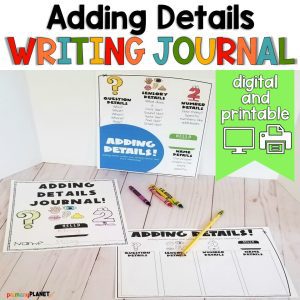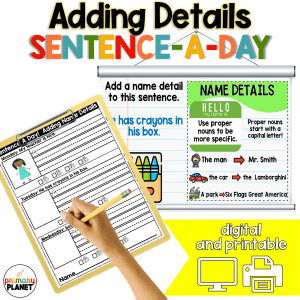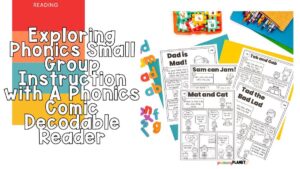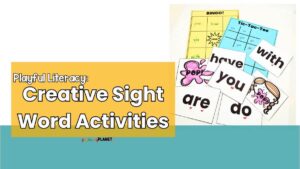
How to Add Details to Writing Mini-Lessons

How to add details to writing is one of the things that I work on teaching my students ALL YEAR LONG! Read on to get more details (see what I did there…)?
How to add details to writing Lesson 1: Sensory Details
Objectives: I can add details to my writing. I can add sensory details to my writing.
First of all, students need to understand what detail is. A detail is something that you add to your writing to make it easier for your reader to understand, or to make your writing more interesting for your writer. Discuss different types of details with your students, then focus on Sensory Details.
Remind students of the 5 senses, and talk about what kinds of details you could add for each sense. Start an anchor chart or use a poster to fill in some sensory details. I usually start with a short sentence, then I add in each type of detail.
I DO Example:
The dog ran.
The brown dog ran. (Seeing Detail)
The stinky dog ran. (Smelling Detail)
The quiet dog ran. (Hearing Detail)
The hungry dog ran. (Tasting Detail) We do have a discussion about not tasting dogs. This is usually good for some giggles.
The soft dog ran. (Feeling Detail)
WE DO: Then, I give them another sentence starter and we work on it together. They turn and talk to their partner first, then we do the same thing together on the board or anchor chart.
YOU DO: Then, I send the kiddos off to work on their mini-task. They will write 2 sentences adding a sensory detail to each sentence. I give them the first sentence, then they can write their own second sentence, or rewrite the first sentence with a different sensory detail.
Differentiate this lesson by giving those kiddos who need more support a prompt or specify what kinds of sensory details to add (what does it look like and feel like). For those kiddos who need more of a challenge, have them try to use all of the types of sensory details.
At the end of our writing time, we share our mini-tasks with our partners. I often will choose one or two students to share their mini-task writing with the whole class.
How to add details to writing Lesson 2: Question Details
Objectives: I can add details to my writing. I can add question details to my writing.
Today we review our posters or anchor chart from the lesson yesterday. Then, we talk about what a question is. We talk about how asking questions can help us add details to our writing.
Like yesterday, I start with a short sentence, then I ask questions to help add details.
I DO Example:
He is a boy.
Sam is a boy. (Who?)
Sam is my brother. (What?)
Sam is coming over later. (When?)
Sam is at the park. (Where)
Sam is at the park with his dog. (Why?)
WE DO: Then, I give them another sentence starter and we work on it together. They turn and talk to their partner first, then we do the same thing together on the board or anchor chart.
YOU DO: Then, I send the kiddos off to work on their mini-task. They will write 2 sentences adding a question detail to each sentence. I give them the first sentence, then they can write their own second sentence, or rewrite the first sentence with a different question detail. I have them write these in their “Adding Details” journal, but you could have your students use this FREE blank journal (in my free resource library. To get access sign up to receive my newsletter below) or just on writing paper that you have in your classroom.

Differentiate this lesson by giving those kiddos who need more support a prompt or prompt them to use specific questions (who and what for example). For those kiddos who need more of a challenge, have them try to use all of the types of question details.
At the end of our writing time, we share our mini-tasks with our partners. I often will choose one or two students to share their mini-task writing with the whole class.
How to add details to writing Lesson 3: Name Details
Objectives: I can add details to my writing. I can add name details to my writing.
Today we review our posters or anchor chart from the lesson yesterday. Then, we talk a little about Names. We briefly discuss that names are proper nouns so should always have a capital letter.
Like yesterday, I start with a short sentence, then I ask questions to help add name details.
I DO Example:
The girl has a dog.
Lucy has a dog.
Lucy has a dog. Its name is Foxy. They like to go to the park.
Lucy and Foxy like to go to Hamilton Park.
WE DO: Then, I give them another sentence starter and we work on it together. They turn and talk to their partner first, then we do the same thing together on the board or anchor chart.
YOU DO: Then, I send the kiddos off to work on their mini-task. They will write 2 sentences adding a name detail to each sentence. I give them the first sentence, then they can write their own second sentence, or rewrite the first sentence with a different name detail.
Differentiate this lesson by giving those kiddos who need more support a prompt or have them use their name. For those kiddos who need more of a challenge, have them try to use a name detail and another type of previously taught detail like a sensory detail.
At the end of our writing time, we share our mini-tasks with our partners. I often will choose one or two students to share their mini-task writing with the whole class.
How to add details to writing Lesson 4: Number Details
Objectives: I can add details to my writing. I can add number details to my writing.
Today we review our posters or anchor chart from the lesson yesterday. Then, we talk a little about numbers. We briefly discuss some number details that we see written in our classroom.
Like yesterday, I start with a short sentence, then I ask questions to help add number details.
I DO Example:
Our classroom
Our classroom is Room 5.
Room 5 has 24 students.
Room 5 is 2nd grade.
WE DO: Then, I give them another sentence starter and we work on it together. They turn and talk to their partner first, then we do the same thing together on the board or anchor chart.
YOU DO: Then, I send the kiddos off to work on their mini-task. They will write 2 sentences adding a number detail to each sentence. I give them the first sentence, then they can write their own second sentence, or rewrite the first sentence with a different question detail.
Differentiate this lesson by giving those kiddos who need more support a prompt on what kinds of numbers to add to their sentences. For those kiddos who need more of a challenge, have them try to use multiple number details in each of their sentences.
At the end of our writing time, we share our mini-tasks with our partners. I often will choose one or two students to share their mini-task writing with the whole class.
How to add details to writing Lesson 5: Adding Details Writing Assignment
Objectives: I can add details to my writing.
Today we review our posters or anchor charts from this week. We discuss all of the different types of details that we can add to our writing. Then I explain that it is time to show me what they have learned! On the last page of our journals the students will be writing a short story (you can give them a prompt, or let them choose what they would like to write about. The story has to be at least 4 sentences long, all about the same topic and they have to use at least one of each type of detail. Remind your students to use correct capitals and punctuation. This piece that I would collect for a grade.
Differentiate this lesson by giving those kiddos who need more support a topic to write about and maybe a sentence starter or two. For those kiddos who need more of a challenge, they can write choose a topic and use more than one type of detail in each sentence.
Love these lessons, but want more? You can get all the lessons, anchor charts, fill-in anchor charts, rubrics, and objectives posters (in both print and digital) in one place! Check it out:
Interested? You can find this fun adding details product here:
or you can check it out on Teachers Pay Teachers HERE!
How to add Details to Writing Video!
Don’t have a ton of time every day? Teach your students how to add details to writing one sentence at a time! Use a Sentence a Day to get your students writing with details and practicing daily! Check out Adding Details Sentence a Day.
Thanks so much for dropping by! I hope that you got some great ideas for teaching how to add details to writing! Pin the image below so you don’t lose these fun writing mini-lessons and the writing mini-task freebie!

Happy Teaching,

Share it:
- Read more about: Writing






